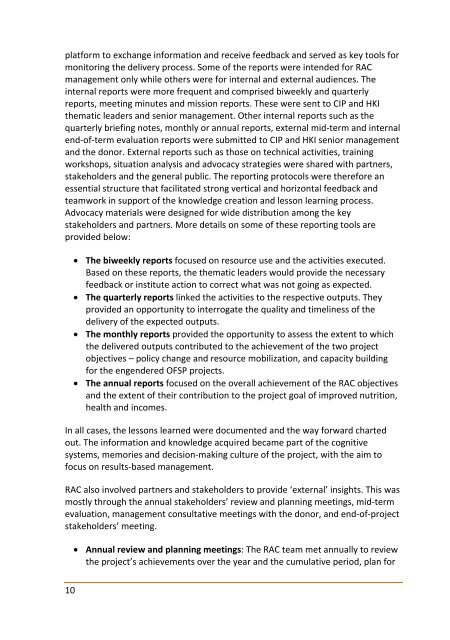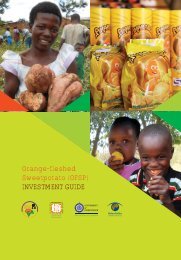Recommendation
Up89Y
Up89Y
Create successful ePaper yourself
Turn your PDF publications into a flip-book with our unique Google optimized e-Paper software.
platform to exchange information and receive feedback and served as key tools for<br />
monitoring the delivery process. Some of the reports were intended for RAC<br />
management only while others were for internal and external audiences. The<br />
internal reports were more frequent and comprised biweekly and quarterly<br />
reports, meeting minutes and mission reports. These were sent to CIP and HKI<br />
thematic leaders and senior management. Other internal reports such as the<br />
quarterly briefing notes, monthly or annual reports, external mid‐term and internal<br />
end‐of‐term evaluation reports were submitted to CIP and HKI senior management<br />
and the donor. External reports such as those on technical activities, training<br />
workshops, situation analysis and advocacy strategies were shared with partners,<br />
stakeholders and the general public. The reporting protocols were therefore an<br />
essential structure that facilitated strong vertical and horizontal feedback and<br />
teamwork in support of the knowledge creation and lesson learning process.<br />
Advocacy materials were designed for wide distribution among the key<br />
stakeholders and partners. More details on some of these reporting tools are<br />
provided below:<br />
The biweekly reports focused on resource use and the activities executed.<br />
Based on these reports, the thematic leaders would provide the necessary<br />
feedback or institute action to correct what was not going as expected.<br />
The quarterly reports linked the activities to the respective outputs. They<br />
provided an opportunity to interrogate the quality and timeliness of the<br />
delivery of the expected outputs.<br />
The monthly reports provided the opportunity to assess the extent to which<br />
the delivered outputs contributed to the achievement of the two project<br />
objectives – policy change and resource mobilization, and capacity building<br />
for the engendered OFSP projects.<br />
The annual reports focused on the overall achievement of the RAC objectives<br />
and the extent of their contribution to the project goal of improved nutrition,<br />
health and incomes.<br />
In all cases, the lessons learned were documented and the way forward charted<br />
out. The information and knowledge acquired became part of the cognitive<br />
systems, memories and decision‐making culture of the project, with the aim to<br />
focus on results‐based management.<br />
RAC also involved partners and stakeholders to provide ‘external’ insights. This was<br />
mostly through the annual stakeholders’ review and planning meetings, mid‐term<br />
evaluation, management consultative meetings with the donor, and end‐of‐project<br />
stakeholders’ meeting.<br />
Annual review and planning meetings: The RAC team met annually to review<br />
the project’s achievements over the year and the cumulative period, plan for<br />
10



